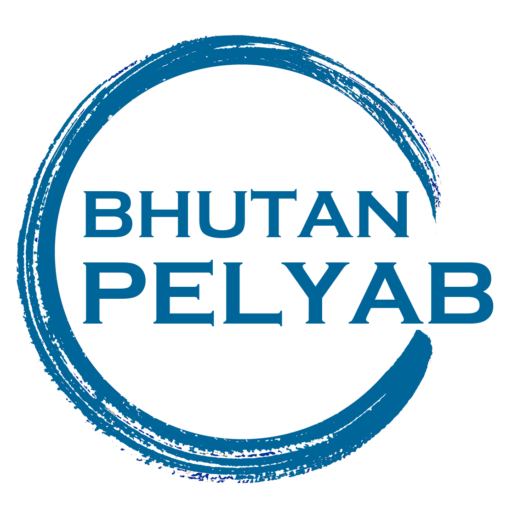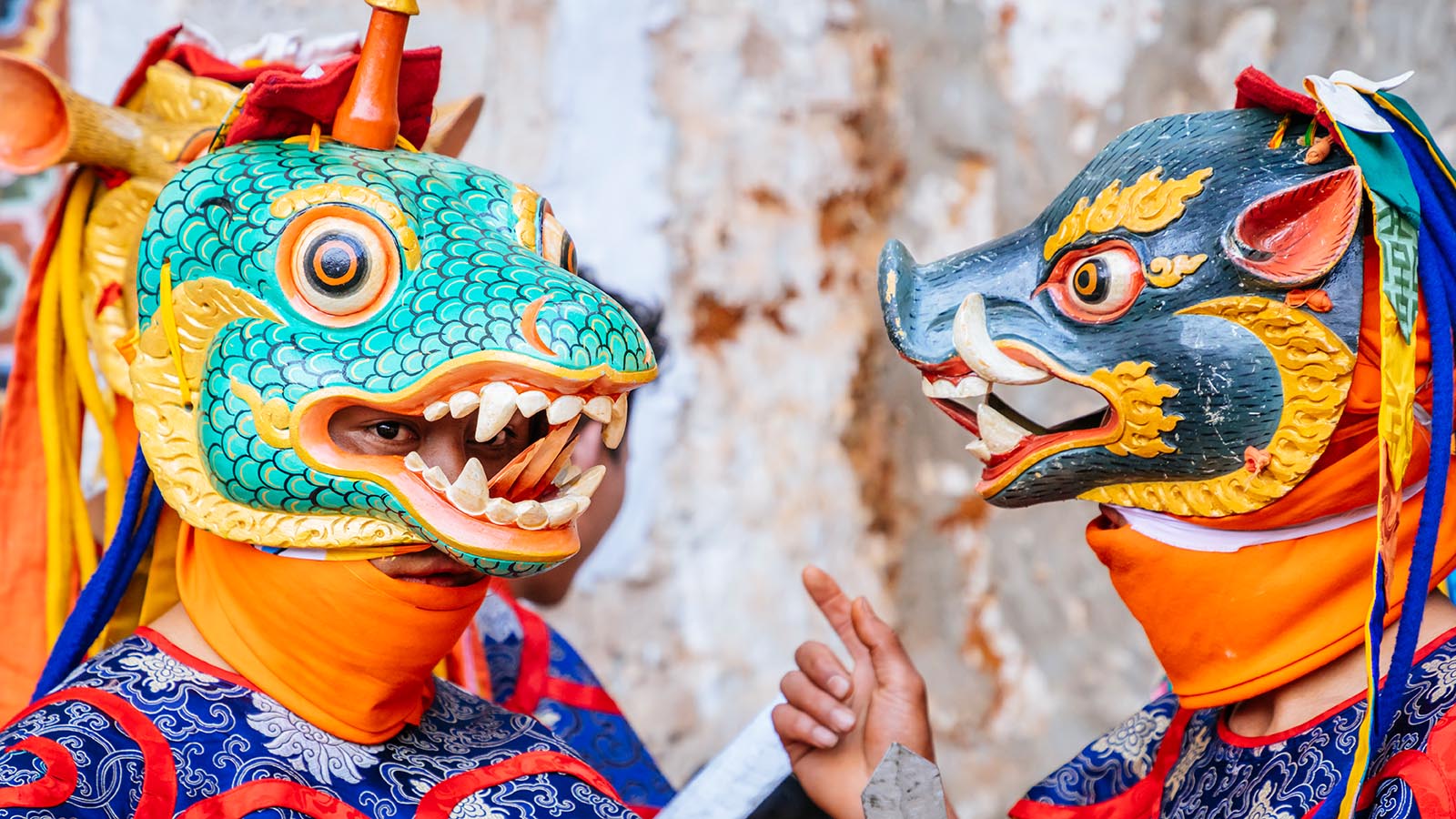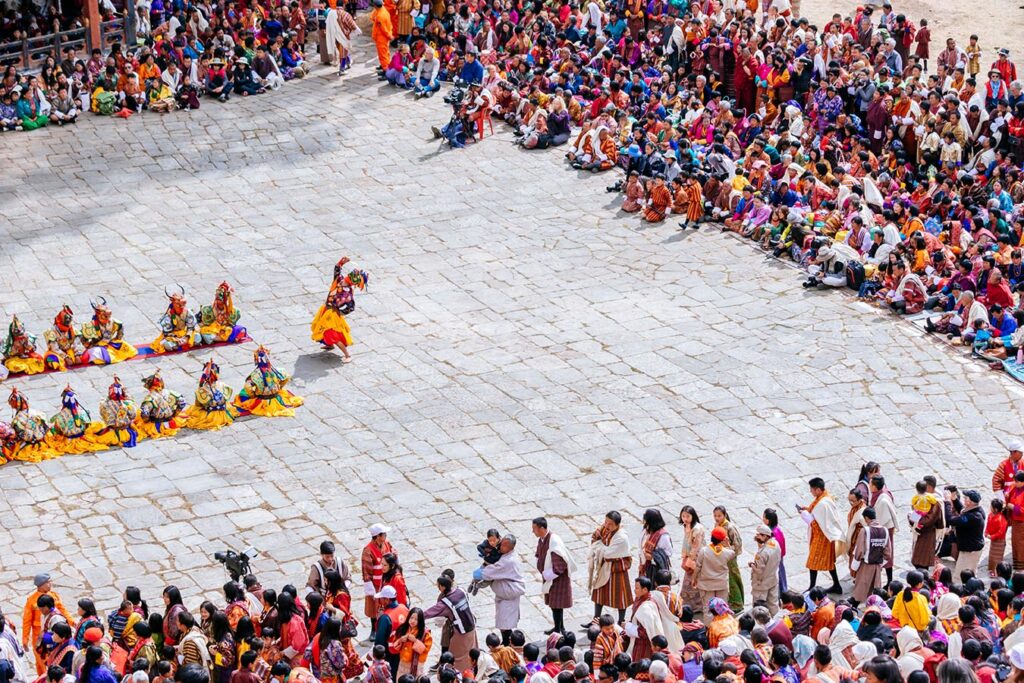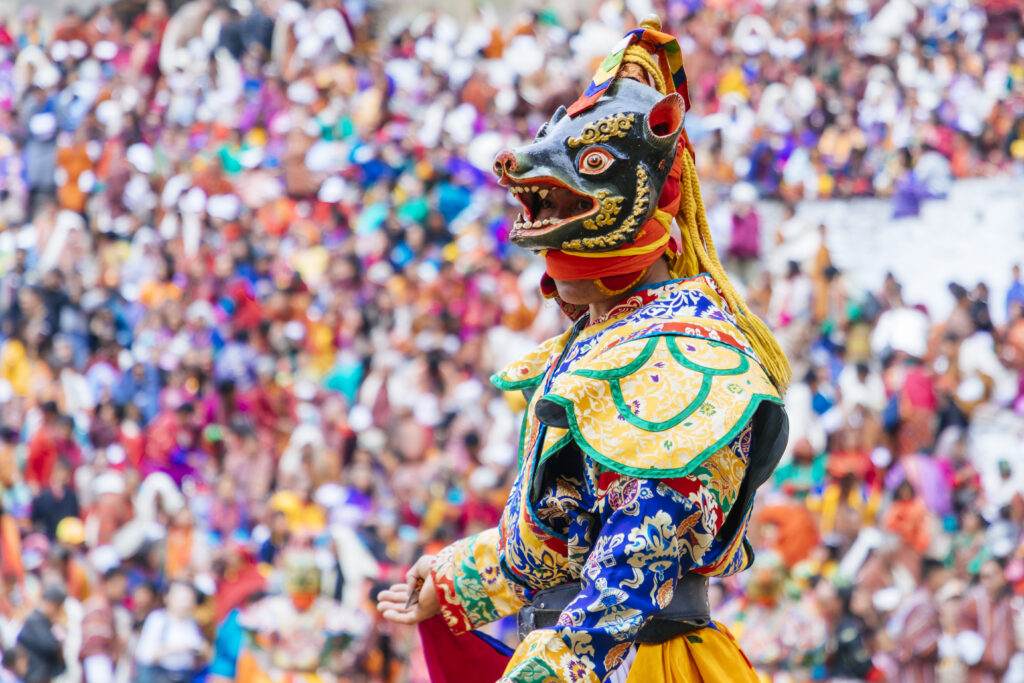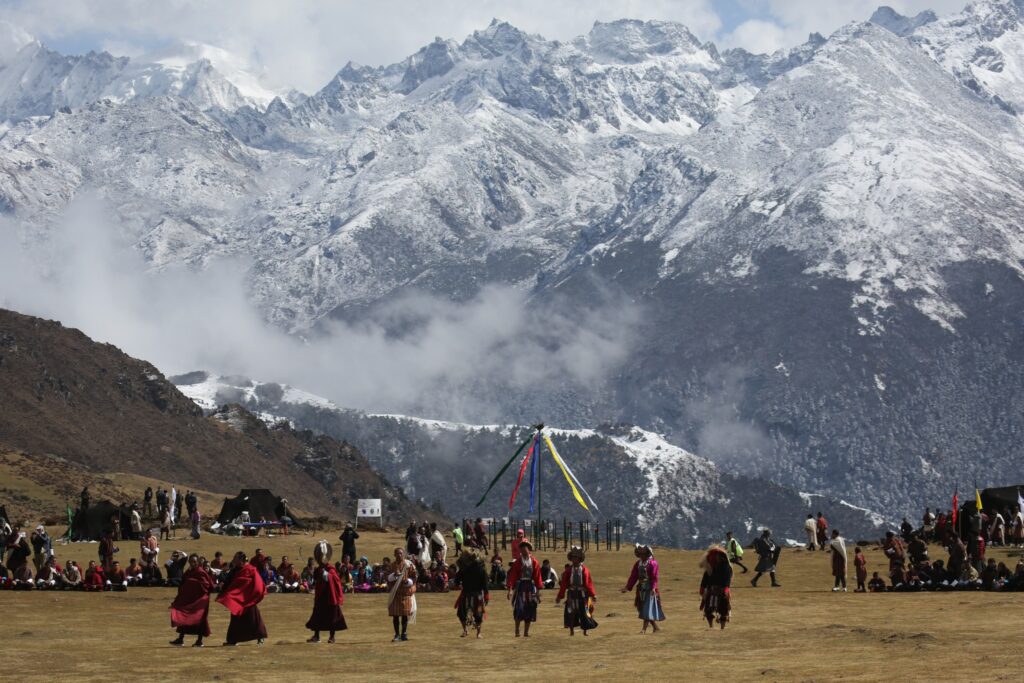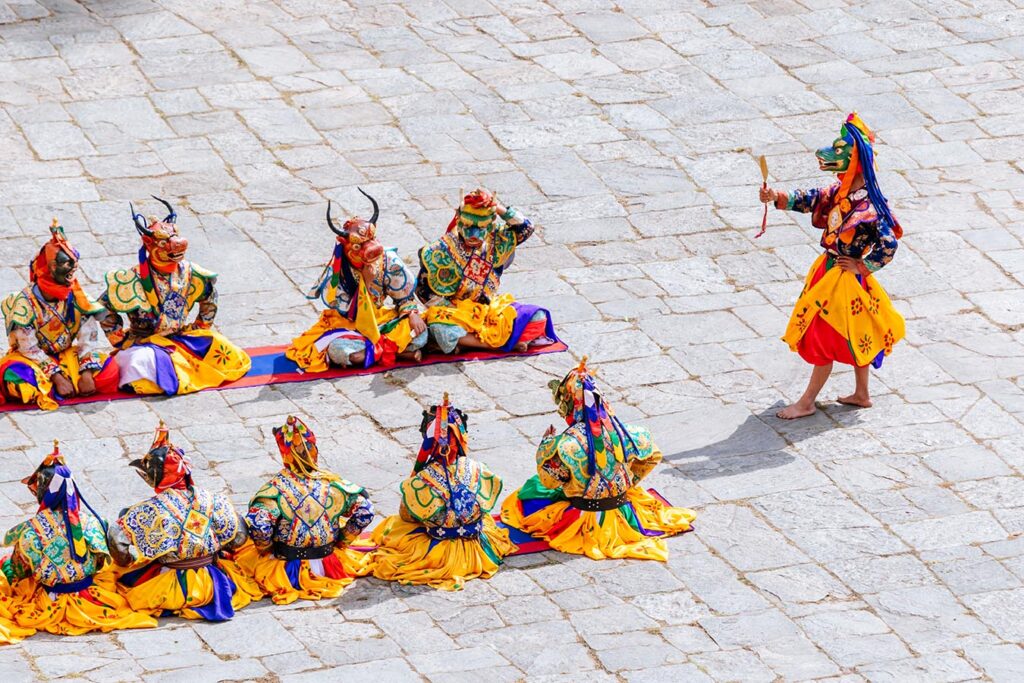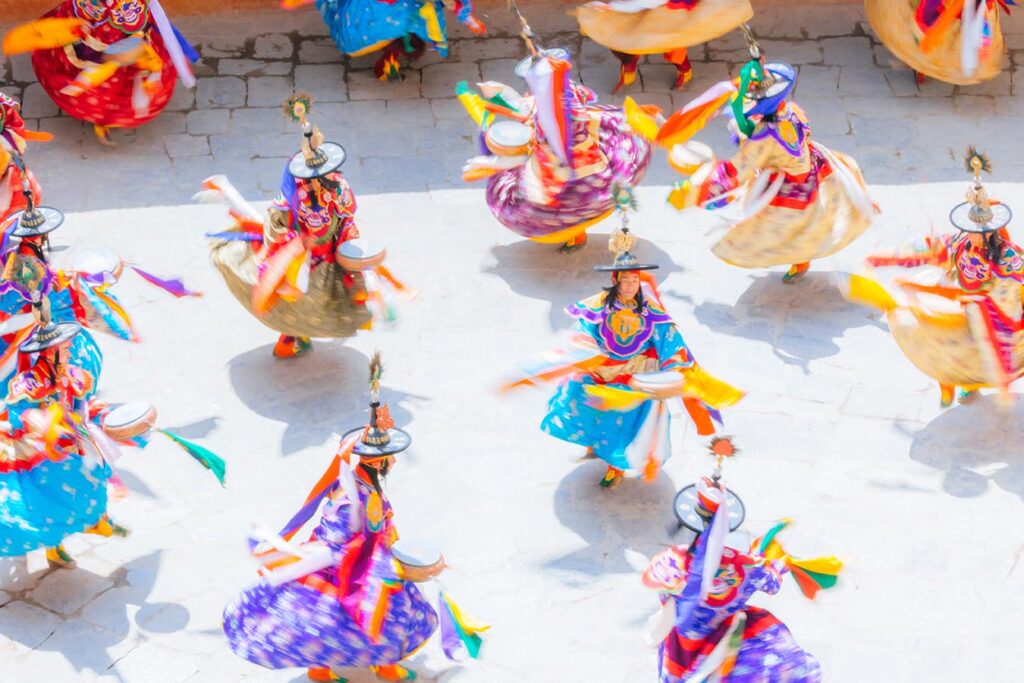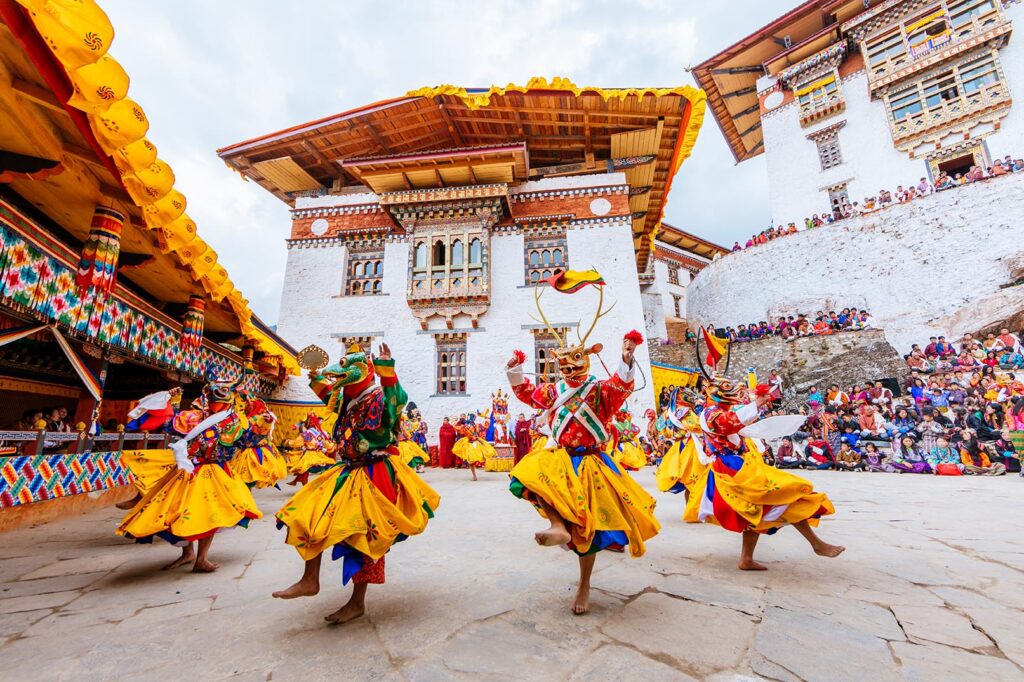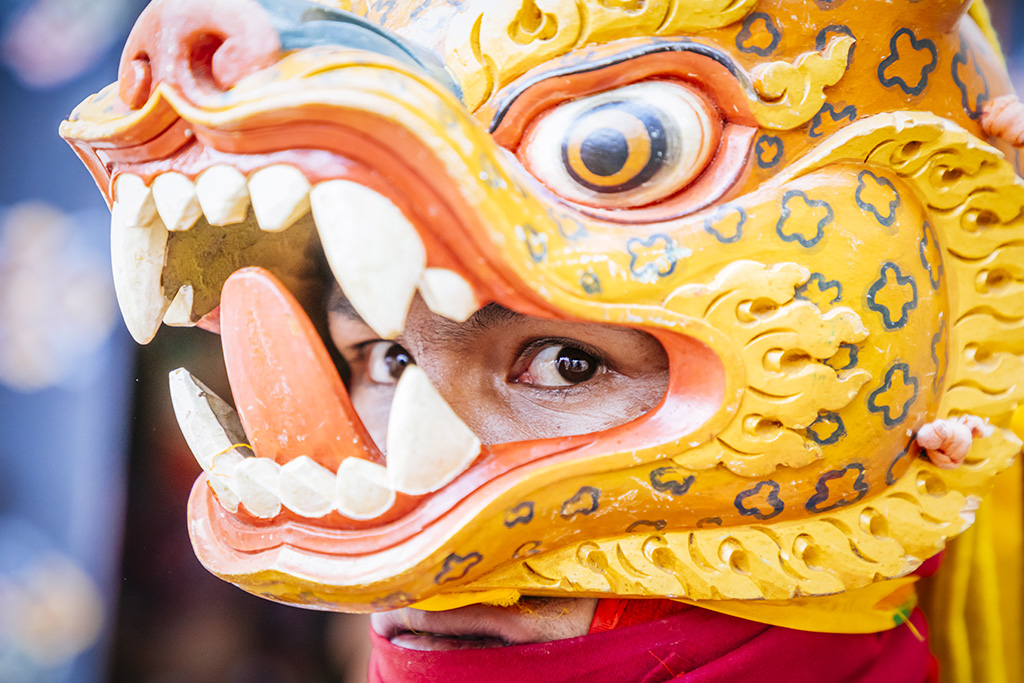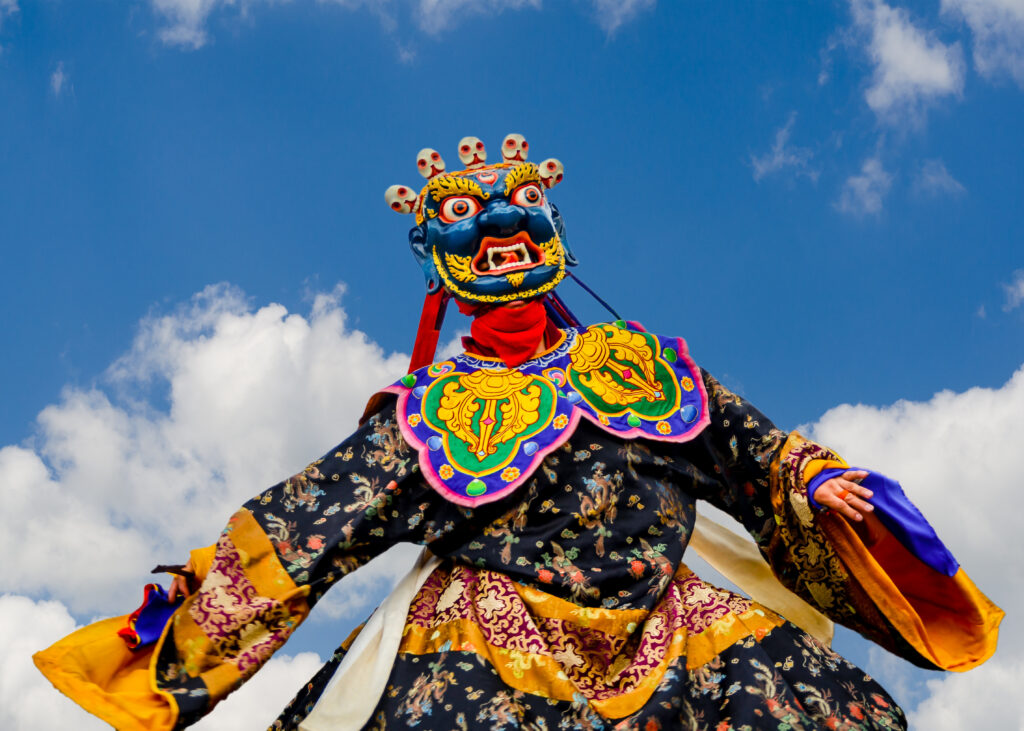Day 1: Arrive in Paro and travel to Thimphu
- Altitude in Thimphu: 2,400m
- Distance: 55km
- Estimated travel time: 1.30 hrs
Welcome to Bhutan, the wonderful Himalayan kingdom with undiscovered beauty. When you arrive, you’ll be able to admire the majestic Himalayas from the airplane window before landing at Paro International Airport. There, our guide will be waiting to welcome you and take you to Thimphu. Your adventure starts here!
Located in the western central part of Bhutan, Thimphu is the capital and also the largest city of the country. It was declared the capital of the Kingdom of Bhutan in 1961 by the 3rd Jigme Dorji Wangchuck. It serves as the seat of the government and the economic center of Bhutan. Thus, it is easier to feel the dynamic life in Thimphu.
After a break, you will head to the National Memorial Chorten in the southern-central part of the city. It was built in 1974 in memory of the Third King, Jigme Dorji Wangchuck and is easily seen from afar with its golden spires and bells. Here, you can observe Bhutanese people engaging in their daily worship.
Your next visit will be the Buddha Dordenma Statue, which is located atop a hill in Kuenselphodrang Nature Park. While driving through the city, you can already see it since this massive Shakyamuni statue measures 51.5 meters tall, making it one of the biggest Buddha statues in the world. The statue is thought to fulfill an old prophecy discovered by Terton Pema Lingpa (Religious Treasure Discoverer) dating back to the 8th century A.D. and to exude a sense of serenity and happiness throughout the world.
Tashichho Dzong (or Thimphu Dzong) will be the last destination for today. This majestic dzong, situated north of the city on the west bank of the Wang Chhu, dominates the valley and looks out over a waterfall of terraced farmland. It is the primary secretariat building, which holds both the King’s offices and the Throne Room.
Don’t miss out on Thimphu’s activities in the evening. You can walk around or visit local stores to see what they have to offer.
You will spend the night in Thimphu at a hotel.
Day 2: Thimphu to Punakha
- Altitude in Punakha: 1,300m
- Distance: 75km
- Estimated travel time: 3hrs
You will go from Thimphu to Punakha today. Also located in the western Bhutan, this city is home to some of the most stunning wonders of the kingdom. It was the capital until 1952, when Thimphu was chosen as the new government seat.
You will stop along the way at Dochula Pass (3,050m), one of Bhutan’s most beautiful mountain passes. The 108 “Druk Wangyal Chortens” honor the soldiers who died in the war against Indian separatists. From the pass, you will have a panoramic view of the Himalayas, with their snow-covered peaks.
The first place to go in Punakha will be the iconic Punakha Dzong (The Palace of Great Happiness), which is positioned right at the confluence of the Po and Mo rivers. This is the country’s second-oldest dzong, built in 1637 by Ngawang Namgyal, the first Zhabdrung Rinpoche. The dzong is a six-story structure with a central tower or utse and a stunning natural landscape.
You will next proceed to the Pho Chhu Suspension Bridge, which is not far from Punakha Dzong. With a length of 160m, it is Bhutan’s longest suspension bridge. As you walk down the bridge, take in the tranquil sights of Punakha Dzong, scenic valleys, and villages.
The last destination to see will be Khamsum Yuelley Namgyal Chorten, known for its distinctive architecture. The complex is regarded as a great example of Bhutanese art and tradition. This chorten was created by Queen Mother Ashi Tshering Yangdon Wangchuck for the well-being of the entire kingdom and the long life of our beloved King.
You will spend the night in Punakha at a hotel.
Day 3: Punakha to Gangtey
- Altitude in Gangtay: 2,900m
- Distance: 87km
- Estimated travel time: 3hrs
You will go from Punakha to the scenic Phobjikha valley in central Bhutan. It has another name – Gangtey valley, referring to the monastery that sits on a ridge above this valley. Phobjikha is a bowl-shaped glacier valley on the western slopes of the Black Mountains, adjoining the Jigme Singye Wangchuck National Park. It is one of the most important wildlife preserves in the country because of the big flock of black-necked cranes that winter here. In addition to cranes, the surrounding hills are home to muntjacs (barking deer), wild boars, sambars, serows, Himalayan black bears, leopards, and red foxes.
Gangtey Monastery will be the first site you visit. Built in 1613, it was the only Nyingmapa monastery in the Black Mountain region at the time, and it is still the largest in the western land today. This magnificent structure offers breathtaking views of Gangtey valley, including expanses of verdant fields, virgin forests, and towering mountains.
Later, you will take on the Gangtey Nature Trail. It is a popular and delightful hike, especially for those wishing to explore Gangtey Valley’s splendor. The paths will descend from a small peak overlooking Gangtey monastery, via gorgeous meadows, and eventually to the village of Semchubara. Following the hamlet, you’ll come across a dense grove of blue pines. You will certainly enjoy the experience of being close to nature while attending to the forest’s inhabitants.
The Black-necked Crane Visitor Centre will be the last stop today. You can learn more about the endangered species, as well as other information about the valley’s flora and fauna, community life, and culture at the centre. Moreover, it is an excellent place to see Black-necked Cranes and other bird species in the valley.
Tonight, you will stay at the hotel in Gangtey.
Day 4: Gangtey to Bumthang
- Altitude in Bumthang: 2,800m
- Distance: 158km
- Estimated travel time: 6hrs
Today’s drive will be quite long. But, on the way, you will stop in Trongsa, which is on the road to Bumthang.
Trongsa is a hilltop town in central Bhutan, also considered the Himalayan Kingdom’s heart. The name Trongsa signifies “new town”. It is a historically significant area where Bhutan’s largest dzong and several important sites are established.
Trongsa Dzong is strategically located high above the raging Mangde Chhu river. The complex, which was finished in 1644, is recognized as Bhutan’s most exquisite dzong. Trongsa Dzong’s unique architecture draws attention from afar. The buildings descend the ridge and are connected by alley-like halls with huge stone steps. Between the buildings, there are lovely paved courtyards. Before it became the decision administration, Trongsa Dzong served as the original seat of force for the Place of Wangchuck.
Ta Dzong, which stands and watches above Trongsa Dzong, used to protect the buildings from internal insurrection. It is now the National Museum, and it houses important Wangchuck Dynasty collections. The collections help visitors appreciate the kingdom’s history. The collections are well displayed, and the artifacts range from antique treasures to deity statues.
You will take a tour of the Yathra Weaving Center, which is located in Umsang village, in the afternoon. You can learn more about the fascinating process of weaving yathras, the local’s unique woven textile with deep colors and mesmerizing designs. It is a specialty that is only found in Bumthang. Yathra is used in making coats, raincoats, bedding material, furniture covers, and accessories.
You will reach Bumthang in the late afternoon and spend the night at the hotel.
Day 5: Bumthang sightseeing
Bumthang is a beautiful region in Bhutan, with lush green mountains and expansive valleys. Bumthang is home to the majority of the country’s most established Buddhist temples and cloisters, earning it the title “strict heartland of Bhutan.” The Tangsibi Mani Tshechu Festival is also held in Bumthang.
You will first visit the famous Jambay Lhakhang, one of the most ancient and sacred temples founded by the 7th-century Tibetan King Songtsen Gampo. It sits on a plateau along the Chamkhar Chhu, offering a great vibe that comes from both the sacred atmosphere and the breathtaking natural sight. The temples were built in one day by the king to tame a Tibetan demon, and Jambay Lhakhang pinned down her left knee.
Then, you will travel to the spectacular complex Kurjey Lhakhang. It can be located at the end of a paved road. Guru Rinpoche’s body (kur) print (jey) is preserved in a cave in one of the complex’s oldest buildings. The temple offers an incredible view of the Bumthang valleys. You can also tour surrounding apple orchards and dairy farms.
Kurjey Drupchu is close to the Lhakhang (meaning sacred water). It is a source of blessing not just for the inhabitants of Bumthang, but also for people across the country. The holy water dates back more than a millennium to the 8th century, when Guru Rinpoche visited Bhutan. According to legend, Guru Rinpoche created the Drupchhu to heal the ill Sindhu Raja, who had welcomed him to Bhutan.
As Tamshing Monastery is located on the other side of the river from Kurjey Lhakhang, you can choose to walk or drive to the site. The walk will take around an hour; it is strongly recommended if you want to view the scenery. The Tamshing Lhendup Chholing (Temple of the Good Message) is Bhutan’s most significant Nyingma goemba. Founded in 1501 by the great spiritual master Guru Pema Lingpa, the site was privately owned by his descendants until 1960. The building’s remarkable design was created by Pema Lingpa himself, with the help of khandromas who carved many of the statues.
We will visit Wangduechhoeling Palace Museum And Cultural Centre. Once the residence of three reigning monarchs, Wangduechhoeling’s galleries recreate the opulent lifestyles of Bhutan’s royal courts through intricate craftsmanship. The revitalized palace grounds, previously home to sacred spaces like prayer wheels and archery ranges, now transport visitors into the nation’s monastic Buddhist past. This reopening consecrates Wangduechhoeling as a vibrant cultural archive upholding its name’s essence – preserving cherished age-old customs for generations to come.
You will stay overnight at the hotel in Bumthang.
Day 6: Tangsibi Mani Tshechu Festival
Today, you will spend the whole day joining the Tangsibi Mani Tshechu Festival. This festival is a wonderful chance for visitors to soak up the culture of Bhutan. Small festivals like Tangsibi Mani offers an authentic experience of local life and have an atmosphere that belongs only to that region.
Tangsibi Mani Tshechu Festival is a three-day mask dance festival hosted by the inhabitants of Tangsibi village at their village temple, Dechenling Lhakhang. This is the most significant ceremony for the villagers since it brings them together and strengthens their community. Almost everyone, regardless of age, station, or gender, is actively involved in preparing for or participating in the celebrations. Dances are performed by monks, laymens or gomchens. Participants learn about old stories and gain meaningful messages by watching these sacred dances.
Tangsibi is a small village around 25 kilometers north of Chamkhar town in the direction of Mongar. It was formerly separated into two parts: Goenbabay (where gomchens mediate) and Krongbay (a cluster of homes), but they merged to become Tangsibi.
Today, around forty homes surround the central temple. The majority of them are farmers who cultivate cattle and cash crops such millet, buckwheat, potatoes, and barley. As you travel through the kingdom, you will notice that while most villagers are farmers, their products are different. Besides, for such a special event, villagers who has gone to live in the city are expected to come home and join the festival.
The central temple is Dechenling Lhakhang – or Tangsibi Lhakhang, where the festival is held. Tangsibi’s community temple, Dechenling Lhakhang, is supposed to have been built by Terton Sherab Mebar, who traveled in the region in search of a suitable place for his seat after being inspired by a prophetic vision. Then he built the temple, which he imagined would be in the center of the four directions, and called it Dechenling.
Residents prepare food, beverage, and entertainment for the festival. Zurpa and threlpa make up the festival’s tsawa, or hosts. The threlpas own more agricultural land and are thought to have more resources than the zurpas, who own less land. During Tangsibi Mani, each household is assigned a certain task. Every year, the specific roles are rotated.
The tsawa begin brewing singchang from fermented wheat grains on the first day of the first lunar month. Mani Chang is the name given to wine preparation. Villagers prepare ingredients for ritual offerings on the 14th and 15th days.
According to oral sources, the mask dances performed during Tangsibi Mani Tshechu festival Mani were instituted by Terton Sherab Mebar during his short stay at Dechenling Lhakhang. They are known as Terton Sherab Mebar’s Tercham, or sacred treasure dances. It is believed that by simply viewing the dances, people can be delivered from the cycle of reincarnations.
On the first day – Tsukton, the dancers will take a purifying bath before assembling for a chibdrel procession back to the temple. The day’s mask dances include the following performances:
- Shinje (Dance of the Bull-faced Male and Female), performed by two dancers.
- Shazam (Stag Dance), performed by four dancers.
- Tsholing – Chung Dhe-nga (Wrathful Garuda-faced) performed by five dancers.
- Durdhag (Dance of the Lords of the Cremation Ground) performed by four dancers.
- Khandro Dhe-nga Garcham is performed by three Khandro (Dakinis), five Zhana (Black Hat Dance), three Tredongla (Monkey-faced) and one Pogorma (the servant).
On the second day – Barton, they will perform:
- Chedang: Eight gadpo wearing swords, shields, and wooden guns enact a war skirmish
- Chungzam (Dance of the Male and Female Garuda).
- Chamchen (Grand Dance. This dance is constituted of eighteen episodes and takes almost half of the day to perform. Locals believe that this is the most sacred mask dance as it is said to have been instituted by Terton Sherab Mebar directly.
- Bardue (Ox Herder): A Pogorma mask dancer performs Bardue Cham during the lunch break.
- In between the chams, the villagers dance and sing folk songs.
- Pholey and Moley Cham (Dance of the Noble Men and Ladies).
And on the third day – Droeton, there will be:
- Zhengzhi Pemi Cham, performed by two dancers.
- Tshog Cham, performed by a dancer in a garuda mask.
- Shinje Cham: Dance of the Bull-faced Male and Female, performed by two dancers;
- Shawa Cham: Dance of the Stag, performed by four dancers.
- Chung Cham: Dance of the Garuda.
- Nyelwai Cham: Dance of the Judgment of the Dead.
- Go Cham: performed by one Raksha (ox-faced) and one Pra (monkey-faced).
- Lokhor Chu-nyi Cham: twelve dancers wearing masks of the twelve animals of the Bhutanese zodiac.
During the dances, you will hear music from trumpets, flutes, and other traditional instruments of Bhutan. These instruments produce sounds that reverberate throughout the space, then at times fast and rushing in rhythm with the dancers’ footsteps. There is no better way to understand and feel the spiritual life of locals than joining a festival like this, watching the performances, listening to the music and watching how people are enjoying every moment of it.
After the festival, the dhalen, or call for voluntary contribution, is held, and the caretaker name the persons in charge of next year’s festival preparations.
As you are here, you will also tour inside the temple. The ground floor serves as the chamgkhang (where the mask dance items are kept, where they will change and relax during the festival), the middle floor is the main altar area, and the attic functions as storage space. The central image in the main shrine room is a massive, newly constructed Guru Nangsi Zilnon statue. There are statues of Guru Pema Jungney (Lotus Born), Buddhas of the Tree Times, and two Chugchi Zhal on the sides (eleven faced Chenrezig). These images are thought to be from the time of Terton Sherab Meba. The temple also houses ancient inscriptions and other sacred treasures attributed to Terton Sherab Mebar.
You will stay overnight at the hotel in Bumthang.
Day 7: Discover Bumthang
Today you will hike to Thowadra monastery (Thowadra means high cliff), one of Bumthang’s most significant pilgrimage locations. It is one of the four sacred cliffs in Bumthang blessed by the visits of Guru Rinpoche and many other great Buddhist masters, another three ones are Choedrak in Chumey, Shugdra in Choekhor, Kunzangdra. Thus, it holds a significant place in the local’s heart.
The monastery was founded in 1238, and named after the cliff it sits on at an altitude of 3,400m, north of the Tang valley. Because of its special location, you will first take a 1,5 hrs drive from Tang valley, followed by another 2-3 hours of hiking to reach this place. The trail will begin near the Karap suspension bridge, then you will pass several chortens and peaceful forest, before ascending hard steps to Thowadra.
The monastery has a main temple and several retreat houses, and Thowadra Lam’s residence above the monastery. Behind the monastery is the cave where Guru Rinpoche and Gelongma Pelmo are said to have meditated. From the monastery, you can enjoy the wonderful sight of the lush landscape below. The hike down will take about 2 hours, followed by a drive back to your Bumthang hotel.
You will stay overnight in Bumthang.
Day 8: Bumthang to Paro by air
In the morning, you will take a short flight from Bumthang to Paro.
You will begin your trip in Paro with the Paro Rinpung Dzong (Fortress of the Heap of Jewels), which is erected on a limestone cliff overlooking the valley. You can see this impressive dzong as you are landing in Paro Airport. With a network of courtyards, temples, offices, and open space surrounded by massive walls, this is a wonderful example of Bhutanese architecture. The courtyard is used for the annual Paro Tshechu Festival, one of the most prominent festivals in Bhutan.
Only a short distance from the Paro Dzong is the Bhutan National Museum – where you will visit next. Formerly called Ta Dzong, the tower overlooks Paro Dzong from a mountaintop. Standing from here, you can get a spectacular view of Paro. The building became a museum in 1968, and now its huge collection includes antique thangka paintings, swords, armor, and natural and historic antiquities. It is a must-see if you wish to know more about Bhutan, its history, and its people.
You will stay overnight at the hotel in Paro.
Day 9: Paro sightseeing
Chumphu Ney is a lesser known site to visitors, but it is one of the sacred sites of Guru Rinpoche. Perched atop a hilltop overlooking Paro, the Chumphu Ney Hike is often described as one of the best pilgrimage hikes in Bhutan, a wonderful chance to connect with the pristine nature.
This day trip will take you out of town, and bring you closest to mother nature. In the morning, we will drive about 1.3 hours to the starting point of the trail. The hike is around 9km and will take approximately 6 hours hike and return. The spiritual journey begins when one crosses the entry gate (Zego) created by two boulders. You will pass through various sacred caves, mystical rocks, and cascading waterfalls associated with Guru Rinpoche, Dakinis, and other Saints along the trail. The connection with nature is the best method to heal the soul.
When you reach Chumphu Ney, you will be able to see a number of wonders. Dorji Phagmo’s mysterious floating statue is housed in the monastery (Vajravarahi). According to legend, the Buddhist Goddess Dorji Phamo flew from Tibet and transformed herself into a statue upon arrival at Chumphu Nye. Besides, you will also visit:
- Numerous caves where Guru Padmasambhava and his consorts, dakinis and legendary scholars were believed to have meditated;
- The gate to heaven;
- Guru Rinpoche’s throne;
- Imprint of Guru Rinpoche;
- Ceremonial robe of the Guru on a rock;
- Stone vase containing the elixir of Immortality;
- Imprints of dakinis/ saints, and rocky cliffs said to contain secret jewels that will be revealed in degenerated times.
If you want, you may take a 20-minute hike uphill to see the nearby holy waterfall (3,246m).
In the late afternoon, you will return to your hotel in town.
Day 10: Discover Paro
In the morning, you will head for Taktsang Monastery (or Tiger’s Nest), one of Bhutan’s most holy destinations. The monastery perches 900 meters above Paro Valley on a precipitous cliff. Due to its unique location, you will need to hike for around 3 hours to reach here, but your efforts will be rewarded with a breathtaking view of the verdant Paro valley and spectacular Himalayan mountains.
According to legend, Guru Rinpoche, riding on the back of a tigress, landed on a sheer rock and meditated there, emerging in eight incarnated forms (manifestations). The complex consists of four large temples with golden roofs, eight caves, and various dwellings.
Taktsang monastery will be the final stop in Bhutan. In the late afternoon, you will enjoy a special with a local family at the farmhouse. This is a great opportunity to meet new people and try Bhutanese cuisine. Traditional Bhutanese cuisine includes Ema Dashi, red rice, Jasha Maru, and Phaksha Paa.
You will also be invited to have a hot stone bath. This is how the Bhutanese relax after a long day of work. They add herbs in the water, which interacts with the minerals from the stones and is really good for your health.
You will stay overnight at the hotel in Paro.
Day 11: Depart Paro
It’s time to say farewell to Paro and the lovely country of Bhutan. We hope that with the assistance of our guide and driver, you have had a great time trip. And we hope to welcome you back to our country one day. Tashi Delek!
